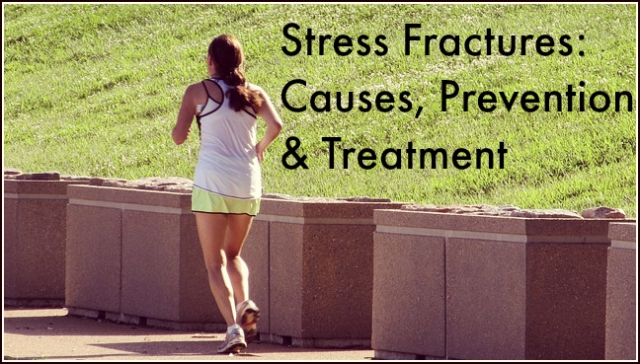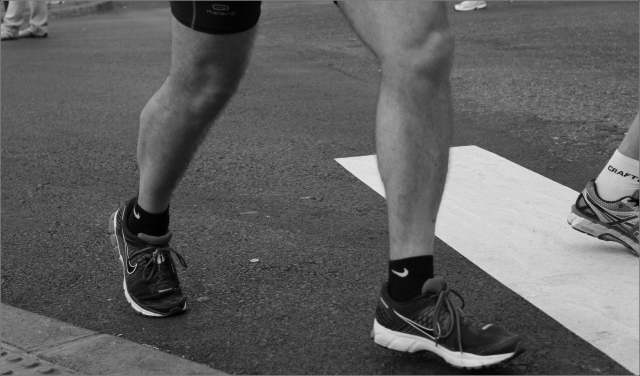If there’s any injury that’s stops runners dead in their tracks, it’s the feared stress fracture.
 In this article, you’ll learn:
In this article, you’ll learn:
- What is a stress fracture?
- How to know if you have a stress fracture
- How to prevent this injury
- How to recover from a stress fracture
Thankfully, this injury is rare compared with most running injuries.
But if you do experience a stress fracture, it can be frustrating. Unlike most other injuries, it requires a lengthy period of no running whatsoever. And you may need crutches or a “boot” to help the healing process.
Sounds like fun, right?
Most runners will never need to deal with a stress fracture. But for those who do, here are the best ways to prevent, treat, and get back to running after this type of bone injury.
What is a stress fracture?
A stress fracture is a small fracture in a bone. In runners, it typically happens in one of the legs. Wikipedia has a comprehensive definition:
A stress fracture, also known as a hairline fracture, is a fatigue-induced fracture of the bone caused by repeated stress over time.
Instead of resulting from a single severe impact, stress fractures are the result of accumulated trauma from repeated submaximal loading, such as running or jumping.
This injury is virtually unheard of in some sports like cycling, swimming, water polo, or diving because there are no impact forces.
But runners experience a tremendous amount of impact force with every step, Every foot strike loads your foot and leg with 2-5 times your body weight!
If you’re not ready for that, you could experience a stress fracture after many months of this repeated, accumulated stress causes your bones to become fatigued (they get tired, too).
There’s also an injury called a stress reaction which is not as severe. It’s essentially a low-grade stress fracture with a few differences:
- The bone is not fractured yet (this is a good thing!)
- There is increased bone-building activity at the reaction site
A stress reaction is the precursor to a stress fracture and if you catch it early, you’ll limit your recovery time and be able to get back to running sooner.
It’s important to note that if you have a stress fracture in your toe, that’s very different than a stress fracture in your femur. Small bones are more likely to break but if you experience a fracture in a large bone like the femur or pelvis, that could indicate some other underlying medical issue that should be addressed as soon as possible.
Thankfully, stress fractures in the large bones of the body are rare. Pay attention to the prevention measures below and you probably will never worry about a femoral fracture…
What causes stress fractures and how do you prevent them?
The main causes of stress fractures are poor training habits. If you’re training hard for a race, you could be more at risk of a fracture if…
- weekly mileage increases too quickly
- duration or intensity of faster workouts increases too quickly
- there’s not enough muscular strength to support the training
- recovery runs are too fast
Ultimately, it’s a case of doing “too much, too soon, too fast.” Bones take a lot longer to adapt to new stressors (like higher mileage) than muscles and connective tissues, so you need a longer time period to adjust.
Running is, after all, an impact sport. It’s you vs. the ground and it’s critical that your body adjust to the increasing demands of training.
Now that we know what causes fractures, we know how to prevent them.
Mileage increases (my mileage article on Competitor can help you with this) should always be conservative when you’re doing more than you have before. The same is true for the duration or intensity of your faster workouts.
Smart training must also include strength exercises and slow paces on recovery days to ensure you’re strong enough to withstand the stress of training and recovering properly.
This is exactly why one of the six pillars of injury prevention is patience in Injury Prevention for Runners, where I go into more detail about my “Patience Protocol” and how to know if you’re increasing too quickly or slowly.
Both injuries – stress fractures and reactions – tend to be more common in women experiencing amenorrhea due to heavy training or calorie restriction. Talk to your doctor to diagnose any other health issues that could be negatively impacting your running.
And remember, stop counting calories!
What does a stress fracture feel like?

A stress fracture feels like your bone is being squeezed by the dirty hand of Satan himself.
Kidding, of course, but it sure ain’t fun.
If you have a stress fracture, you’ll know something is very wrong. This injury presents with sharp, burning localized pain directly where the fracture is located. It may even be painful to touch.
But a stress reaction may feel different. There could be a burning or aching pain on the bone at the site of the injury. The surrounding muscle could even feel tight.
Pain from a fracture will get progressively worse as you run. And if you keep running, the pain may be present while walking or even sitting.
While an x-ray may be able to spot a big stress fracture, a bone scan or MRI is needed for most cases and certainly for stress reactions. Since there’s no fracture, a bone scan or MRI will show more bone-building at the site of the reaction.
If you suspect you have either bone injury, get to a doctor (an orthopedist is generally the best option) as soon as possible to properly diagnose the injury and get your definitive prognosis.
Stress fracture treatment
Once you have a firm diagnosis of “stress fracture”, it’s time to rest (after you stop sobbing – don’t worry, I’d cry too). The only thing you can do is rest – there’s not much else that will speed the healing process.
Depending on the severity of the fracture or stress reaction, the doctor will typically prescribe 6-12 weeks of rest. This means no running whatsoever.
It’s very important that runners listen to this advice. There’s literally a hairline fracture in the bone so any running is only going to make it worse. Do not try to run on a stress fracture.
If the fracture isn’t severe, the doctor may allow some non-impact cross-training like aqua-jogging which can help maintain fitness levels.
But other exercise can be risky even if there’s no impact, like:
- Cycling
- Strength training
- Elliptical
- Stair climber
Ask your doctor about whether it’s safe for you to enjoy these types of exercise during the recovery period. They’ll make your return to running a lot easier if they’re allowed.
Post-Injury Evaluation
During your recovery, it’s helpful to evaluate your prior training to determine what can be improved. Ask yourself:
Did my mileage jump up too quickly?
Did I run more frequent fast workouts than I was used to?
Or did I run my workouts at too fast a pace?
Is my cadence (steps per minute) over 170?
Am I getting a regular period?
Am I eating enough and getting enough high-quality nutrients (especially calcium and Vitamin D)?
Have I been doing regular strength workouts?
This is the least fun part of recovery: identifying your training mistakes so you can prevent stress fractures in the future. But it can be really valuable, just like a running “annual review.”
As you (slowly) begin running again, figuring out what aspects of your running can be improved will help you be more consistent (the “secret sauce” of successful running) long-term by staying healthy.
While most stress fractures are caused by the “3 Too’s” of poor training progression, diet plays a role as well.
Once you’re running again, it’s important to increase your mileage very gradually (the “10% Rule” is too aggressive in this scenario) and avoid faster workouts for at least a month.
You may also find it beneficial to run on softer surfaces like grass. Now could be a good time to also start trail running!
The reason is not necessarily the softer surface, but rather the irregular surface. Your foot lands and responds to the terrain in slightly different ways with each foot strike, which varies the stress your legs experience.
Once you dial in your training, pacing, and diet, most runners shouldn’t worry about stress fractures.
What other questions do you have about stress fractures? Leave it below and I’ll try to respond to every question!